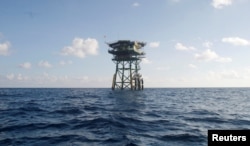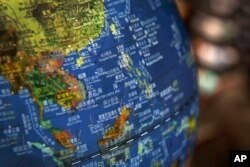Both China and Vietnam are building up small islands in the South China Sea, a waterway known in Vietnam as the East Sea.
China has received a lot of criticism for its actions there. But Vietnam receives very little international criticism. In fact, the country even gets some support because the speed of its island-building project is slower and widely seen as defensive.
There are several differences between the ways the countries are operating in the South China Sea. First, Vietnam has held its islands for many years. In addition, the areas where work takes place are close to the Vietnamese mainland. The country avoids military projects that might appear offensive. Lastly, Vietnam belongs to the Association of Southeast Asian Nations (ASEAN). That organization is known for helping its members work out any differences.
Alan Chong is an associate professor at the S. Rajaratnam School of International Studies in Singapore. He explains that Vietnam and neighboring ASEAN nations have kept to the areas near their borders around the sea.
"They've never had, I think, a standoff with any other country," Chong said. He added that within ASEAN, members do not want to cause each other trouble "so as to present a common front towards China."
The Asia Maritime Transparency Initiative said in a report on April 8 that Vietnam has "slowly" added buildings on some of its 10 islands since 2017. The initiative is a project of the Center for Strategic and International Studies, a research group based in the United States.
The report also noted new communications equipment, a sports field and the extension of an airport runway on Vietnam’s largest property in the Spratly Islands.
Securing occupation
On some of the islands it occupies in the Spratlys, Vietnam has built up land where there was once water. Some buildings are getting solar equipment, the report said. It also noted 25 guard houses that Vietnam has built on places that are sometimes underwater.
Trung Nguyen is international relations dean at the Ho Chi Minh University of Social Sciences and Humanities. He said that Vietnam is "very slowly" reclaiming land so that it can protect properties from bad weather. That effort has avoided use of large ships that might get too much international attention, he said.
"The Vietnamese government has made it very clear they just reclaim the islands for self-defense, and they do not expand massively for other purposes," Nguyen said. "I don't think the Vietnamese government wants to draw a lot of attention from other countries on their reclamation, so that's the reason they want to do it quietly."
The Vietnamese government hopes the small islands can continue without much help from the country’s mainland, Chong said. He added that Vietnam is preparing for a "long stay" on the small islands.
Gregory Poling is director of the Asia Maritime Transparency Initiative. He said Vietnam is developing islands to make them harder for China to take without a cost, not for offensive military use. Poling said the Vietnamese goal seems to be "making these facilities more survivable, raising the cost for the Chinese to to take them."
China's building speed
China claims about 90 percent of the South China Sea. The area it claims includes some of the waters Vietnam claims and areas that four other governments call their own. The four are Brunei, Malaysia, the Philippines and Taiwan. Chinese reclamation work is especially upsetting to Vietnam because China controls the full Paracel island chain, also claimed by Vietnam, and three major islands in the Spratly chain.
China’s island-building work has led to the deployment of military aircraft and radars, the initiative said. Chinese crews had used 1,294 hectares of reclaimed land to help develop coral reefs and atolls under their control, the U.S. Defense Department estimated in 2016.
China gets the attention of other countries, including the United States, when it sends bombers and naval ships into the waterway. Both China and Vietnam say this is acceptable because they have long used the sea for military purposes.
Keeping peace
China and the Philippines have criticized Vietnam over the years because its islands fall into the areas they claim. But experts believe the criticisms do not continue because the other countries do not see Vietnam as a threat.
Vietnam spends less on its armed forces and maritime development budget than China, which is Asia's top economic and military power. Chinese officials meet sometimes with ASEAN leaders. However, China is not invited to regular events for Southeast Asian heads of state, defense chiefs and foreign ministers.
Oh Ei Sun is with the Singapore Institute of International Affairs. He told VOA that ASEAN members will probably not fight each other.
"One ASEAN country is not going to war with another ASEAN country. We would find consensus. That's the true spirit of diplomacy."
Japan and the United States have also supported Vietnam in its island claims. Japanese and U.S. officials each want to limit Chinese expansion. Japan agreed in 2014 to donate six coast guard vessels to Vietnam. The U.S. Navy regularly passes ships through the sea to warn China.
I’m Jill Robbins.
And I'm Pete Musto.
Ralph Jennings reported on this story for VOA News. Jill Robbins adapted it for Learning English. George Grow was the editor.
______________________________________________________________________
Words in This Story
standoff – n. an argument or contest in which there is no winner
common front - n. n alliance between different groups, forces, or interests in pursuit of a common goal or in opposition to a common enemy
initiative – n. a plan or program aimed at solving a problem
runway - n. a long strip of ground where airplanes take off and land
solar - n. produced by or using the sun's light or heat
reclaim - v. to make (land) available for use by changing its condition
draw - v. to cause (attention) to be given to someone or something
massively - adv. in a large way
maritime – adj. of or relating to the sea
consensus - n. an idea or opinion that is shared by all the people in a group
What do you think of Vietnam's activity in the South China Sea? We want to hear from you. Write to us in the Comments Section.











